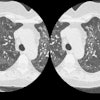AJR Am J Roentgenol 1987 Jul;149(1):15-21
MR imaging of pulmonary arterial hypertension and pulmonary emboli.
White RD, Winkler ML, Higgins CB
Intraluminal signal in the pulmonary arteries on spin-echo, ECG-gated MR images is limited to the diastolic phase of the cardiac cycle in normal subjects. Initial experience has indicated that signal persisting during systole may be characteristic of slow blood flow associated with pulmonary arterial hypertension (PAH) or of thrombotic material secondary to pulmonary embolism. This study analyzes our cumulative experience (31 patients) with multiphasic, double spin-echo MR for assessing PAH and/or suspected pulmonary embolism. In PAH, the abnormal systolic signal showed an intensity increase from first to second echo. This pattern was observed in 92% of PAH patients, including 100% of patients with pulmonary systolic pressures greater than or equal to 80 mm Hg and 60% of patients with pressures less than 80 mm Hg. At any focus in the pulmonary arteries, such signal disappeared at some phase of the cardiac cycle. In patients with pulmonary embolism, signal from thrombus was fixed throughout the cardiac cycle and showed little or no increase in relative intensity change from first- to second-echo image. Using this guideline, MR made six confirmed positive and four confirmed negative diagnoses of proximal pulmonary embolism, while it failed to identify thrombus in the one patient with a peripheral pulmonary embolism. Intraluminal signal in the pulmonary arteries caused by PAH or pulmonary embolism can be differentiated in most instances using multiphasic, double spin-echo, ECG-gated MR. However, at its current stage of development, the procedure does not appear to be useful for the evaluation of peripheral pulmonary embolism.
PMID: 3495975, MUID: 87238265







